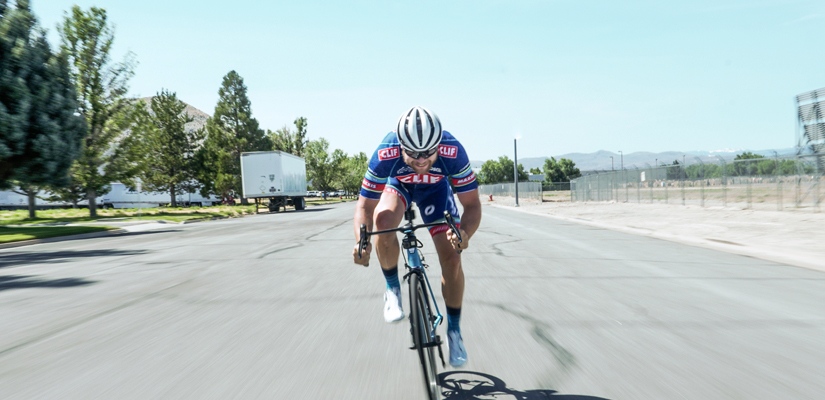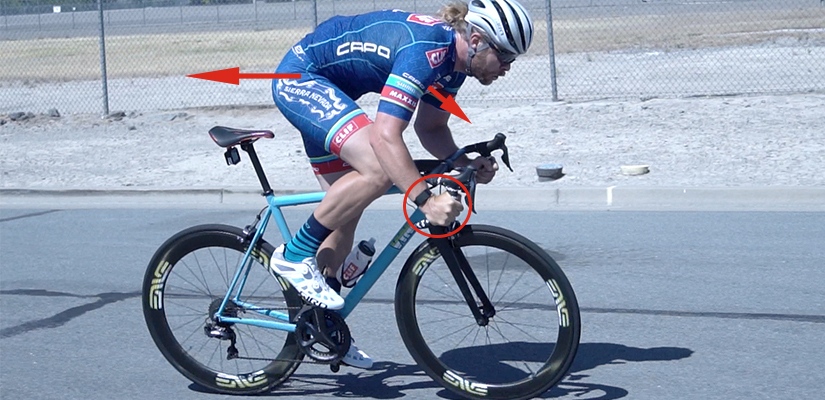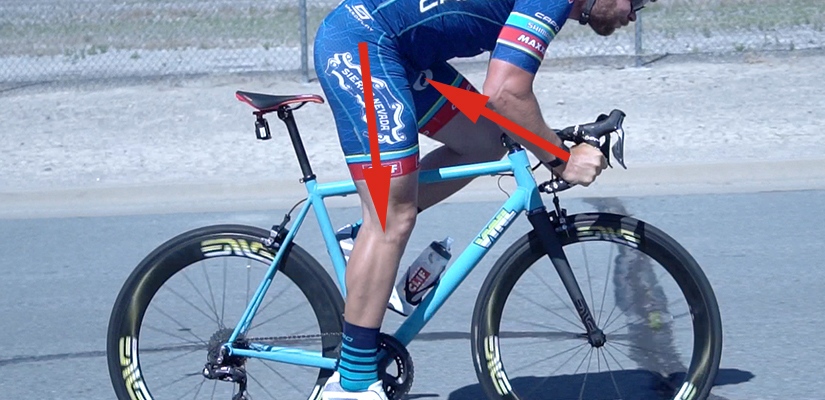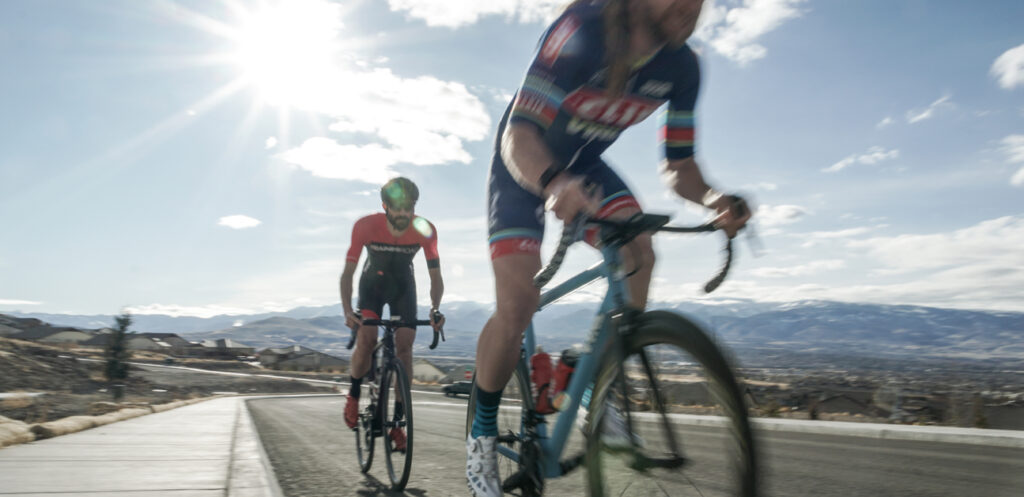Cycling Sprint Technique: How to Sprint Faster

A powerful sprint is more than a burst of acceleration and power. Proper tension, body position, and rhythm will improve your cycling sprint technique. We’ll cover the techniques that will help you put out maximum power and sprint faster on the bike.
For more on race tactics check out our Race Analysis YouTube Playlist.
Fine Tuning Your Cycling Sprint Technique
The main goal with any sprint is to go faster, but we’ll specifically cover how to sprint faster out of the saddle in this article. Proper body position and technique in a standing sprint will not only maximize your force output but will make sure the force is making it into your pedals and translating to real speed increases.
Subtle changes in sprint technique can make significant differences. Fine-tuning body position, tension, and rhythm can help you execute a powerful and explosive sprint.
Setting up to Sprint Faster
Instead of jumping out of the saddle into a full sprint, prepare for your sprint with intention and focus. As you prepare to sprint, position your hands at the top of the drops, tucked in behind your shifters, instead of down by the bar ends. When rising out of the saddle, focus on hinging forward at the hips instead of bending your waist and back. This puts you in a flat back position that reinforces efficient tension and power transfer when you pedal.
Road Bike Sprint Position
Your sprint position will vary depending on bike fit, but an indicator of good body position is if you can feel your saddle’s nose brushing up against the back of your hamstrings. Generally, you want a flat back and positioned far enough back for balance and to enable your anchor points.

Once you are in optimal sprint position, focus on distributing tension into your body. Evenly disperse tension into your core, chest, arms, back, and hips. Actively engaging these muscle groups will not only make for a snappy start but will allow you to maintain control of the momentum of the sprint from start to finish.
How to Sprint on a Bike
The first few seconds of sprinting are critical; this is where you establish the proper technique to carry you through the rest of the sprint. Your hips and your handlebars are the main anchor points during your sprint. To engage your anchor points make sure your hips are hinged, and your hands are firmly placed high up in the drops. With your body in the proper position and tension maintained throughout your body, you are ready to apply force.
1. Create A Circle of Power
Inefficient power transfer during a sprint is a problem many cyclists have but may not realize. Usually, this is manifest by a “noodly” or “wild” sprint technique, with too much energy going into an excessive bike or body movement rather than going directly into the pedals.
Cock your wrists by slightly curling the hands in and wrists out. Next, move your elbows slightly outward into a stronger position, and apply inward force on your bars in such a manner that you feel like you are bending your bars inward toward each other. This is the Circle of Power.
2. Use Opposing Tension
When you exert force in your pedal stroke, pull the bars towards your hips, rather than up or back. Do this with each pedal stroke – pulling your left drop into your hip when you exert force on your left pedal and pulling your right drop into your hips when you exert maximum force on your right pedal. As you repeat this action and increase your comfort level, you will naturally fall into a smooth rhythm that we all recognize as the sprinter’s sway.

The reason this swaying happens is due to applying opposing pressure through your handlebars and pedals. This means that while your left foot is at its point of peak force in the pedal stroke (about the 1:00 – 2:00 position), you will also be applying peak force on the right handlebar by pulling towards the hip. As you move closer to 5:00 and 6:00, you transition to making the same motion but mirrored to your right side.
If you aren’t matching your leg’s peak force with the peak force of the opposite arm, you are missing out on peak power output. Interestingly, this can be manifest in two opposing ways – either your bike will not be wagging side to side at all, or it will be doing so excessively. When it’s matched well, there will be lateral movement, but it will be minimal. As you improve your technique and strength, your lateral movement will likely decrease.
3. Maintain Body Tension
As the speed of your pedal strokes increase and everything starts to happen at a faster rate, it can be challenging to maintain the same body position and technique. If body position falters and you round your back, it will be tough to maintain tension through your body. If tension is lost, you’ll stop retaining all of that force you are putting into the pedals, and coordination will falter.
4. Let the Saddle Brush Your Thighs
Another problem many cyclists have is finding the fore and aft balance point while sprinting, which usually causes the back wheel to lift into the air. In many cases, cyclists are putting too much attention on maintaining a low upper body. While this is aerodynamically efficient, it can easily rob you of peak power and, worse yet, cause a crash.
To check if you are in the proper position, the tip of your saddle should just barely brush the back of your thighs while the bike goes side to side.
As you get more comfortable, feel free to lower yourself while sprinting. Instead of lowering just your upper body and throwing off your balance, try lowering your entire body, so your saddle still brushes your thighs, but you are in a lower, more crouched position.
Practice Your Cycling Sprint Technique
Faster sprinting is as much about technique as it is your ability to produce a lot of force, so practicing technique is key. Because sprinting is a peak-effort activity, fatigue ramps quickly, and with fatigue comes increased difficulty in maintaining proper technique.
Sprint Technique Drills
The best way to improve your sprinting technique is to integrate sprinting drills into your regular workouts. If you find it challenging to maintain proper technique while putting out peak power, drop your power output down a bit and prioritize technique.
Start by practicing with low cadence, low effort, and low-speed drills. Then work your way up as your comfort increases. Remember, you don’t have to go all out in every practice sprint. Start low and work your way up gradually.
Shifting During a Sprint
Shifting adds additional complexity to your sprint and has the potential to be dangerous. To avoid jumping gears in the middle of the peak force phase of a pedal stroke, time your shifts so that the chain switches gears just before your cranks reach the 12 o’clock position. Remember to ease up ever so slightly on the force when you shift. This allows your chain to easily and safely change gears. Practicing good shifting habits now can be the difference between a winning sprint and a broken chain.
Break it Down
If it helps, you can also break down your sprints when you practice. The preparation, the start of your sprint, and the end of your sprint can all be worked on and adjusted separately. Focus on making precise changes within each aspect of your sprint to increase the efficacy of the sprint as a whole.
When you work on your cycling sprint technique, try not to worry too much about speed or power, and focus on technique. As you sharpen your skills and proper technique becomes second nature, speed and power will come naturally. The more you fine-tune your sprint, the faster your sprint will be.
More on Sprinting:
- How to Improve Your Maximum Sprint Power
- How to Accelerate Past Someone in a Sprint
- Pro Tips for Sprinting When Your Breakaway Fails
- How to Find the Right Wheel in a Sprint
For more cycling training knowledge, listen to the Ask a Cycling Coach — the only podcast dedicated to making you a faster cyclist. New episodes are released weekly.
